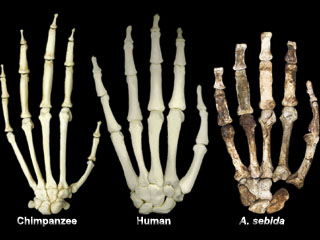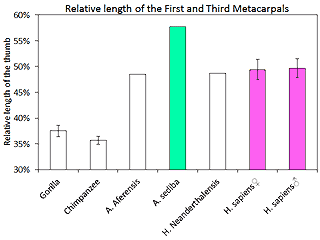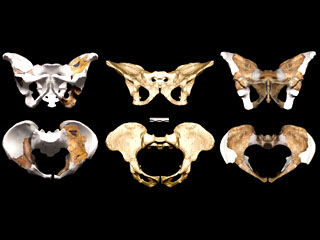Australopithecus Sediba: The Missing Link Between Apes and Humans?

Introduction
According to numerous newspaper articles,1 the missing link between humans and apes, Australopithecus sediba, has been found by paleontologists in South Africa. However, the scientists who made the discovery and published the research on it are not quite so confident about where the new fossil fits in the hominid "family tree." In fact, the bones do not represent a logical sequence of "evolution" from the ape-like Australopithecines to the more human-like Homo erectus. Realistically, Australopithecus sediba looks more like a specialized ape that had no contribution to humankind.
Human family tree?
Numerous discoveries have been made that show that hominin species represented a diverse collection of animals over the last 4 million years. Although originally envisioned as a tree, these discoveries show that the "family tree" is more like a bush or hedge, with the different species belonging to seemingly separate branches. One of the biggest puzzles for paleontologists has been the evolution of the genus Homo from the genus Australopithecus, since there are dramatic differences between the two genera (brain size, overall height and numerous bones associated with bipedalism). Hence paleontologists have been looking for the "missing link" of human evolution.
Missing link?
A new species of Australopithecine, Australopithecus sediba, consisting of two partial, but well-preserved skeletons, was discovered in 2008 in Malapa cave in South Africa. After painstaking preparation and documentation, the initial studies of the fossils have been published in the journal Science.2 The creature is a curious combination of primitive ape, with a small brain (420 cc), long arms, a small body, and a narrow birth canal, but with Homo-like features consisting of short fingers, a long thumb, and composite foot. The rock in which the skeletons were found has been dated to ~2 million years ago—between the dates for the Australopithecine and Homo species.
Although Australopithecus sediba, falls into the right time frame to be a "missing link" it is not an intermediate between Australopithecus and Homo. Overall, Australopithecus sediba exhibits primitive features characteristic of other Australopithecines. The brain size is even smaller than an average Australopithecine, and only marginally larger than that of a chimpanzee. The creature has anatomy characteristic of tree-dwelling apes—long arms coupled with curved fingers and a heal designed for climbing, along with small body size. However, the creature had small fingers similar to humans and a longer thumb.3 Even so, the thumb is not intermediate between chimpanzees and modern humans, but actually much longer than that of modern humans relative to finger size (see graph to right and picture above). Why Australopithecus sediba had such long thumbs is unknown. Study author Lee Berger speculated that Australopithecus sediba had evolved its unusual hand in order to use tools, although no such tools have been recovered from the Malapa site.
Researchers unearthed two partial pelves of Australopithecus sediba, which are shown reconstructed (right, reconstructed portions in white). Like the rest of the Australopithecus sediba skeleton, each pelvis of the two specimens represent a curious combination of Australopithecine and Homo attributes. The pelvis is still small relative to humans, but has some characteristics found in the genus Homo. However, since much of the rest of the skeletons suggest Australopithecus sediba was adapted to both arboreal and terrestrial bipedal means of locomotion, these findings are not surprising. Current theories on the evolution of the human pelvis claim that the evolution of the pelvis was primarily driven by the need for large birth canal to birth large-brained babies. However, since Australopithecus sediba was very small brained, natural selection could not act on a trait that did not yet exist. Not to be phased by the contradiction, the study authors claim that some unspecified requirement of bipedalism was driving the evolution of the Australopithecus sediba pelvis.
The publication on the skull of Australopithecus sediba is an amazingly speculative piece. What is truly amazing is that the article survived peer review in its final form. It talks about "neurons," "neural reorganization," "neural morphogenesis," and "neural interconnectivity" even though there were no neural remains at all. What the researchers did was to do a virtual endocast of the brain case to get the putative shape of the brain. The problem with such a study is that they did a very limited comparison to the crania of other Australopithecines, most of which were much less well preserved and complete than their pristine fossil. Was this a fair comparison? Probably not. Even though the brain size was smaller than the average Australopithecine, study authors concluded that the "results are consistent with gradual neural reorganization of the orbitofrontal region in the transition from Australopithecus to Homo." Amazing!
Conclusion 
The discovery of a putative new species of a new species of Australopithecine, Australopithecus sediba is indeed a remarkable fossil find. However, what is even more remarkable than the fossils is how the referees at Science let the study authors speculate so freely about the implications of the find in relation to human evolution. It's almost as if the magazine is so desperate to find something linking the genera Homo and Australopithecus that they allowed wishful thinking into the publication articles. Rather then being a "missing link" in the human family tree it would appear that Australopithecus sediba is yet another species in the hedge that defines the hominins.
Related Pages 
- Descent of Mankind Theory: Disproved by Molecular Biology
- The Human Difference: How Humans are Unique Compared to All Other Animals
- Human Y-Chromosome: 'horrendously different' from Nearest Living 'Relative'
- Out of Africa or Out of Eden: Does Science Contradict the Bible?
- The Origin of Mankind and the Races
 Who Was Adam?: A Creation Model Approach to the Origin of Man
Who Was Adam?: A Creation Model Approach to the Origin of Man![]() . Are
humans just advanced apes or have they been specially created in the image of
God? Publications by scientists almost never ask the question, whereas
publications by theists seldom examine the scientific data that relates to the
question. However, two scientists raised in non-Christian homes, Fuz Rana (Ph.D.
in chemistry) and Hugh Ross (Ph.D. in astronomy), have written a new book (Who
Was Adam?: A Creation Model Approach to the Origin of Man) that examines
the question of human origins by comparing biblical and evolutionary models.
. Are
humans just advanced apes or have they been specially created in the image of
God? Publications by scientists almost never ask the question, whereas
publications by theists seldom examine the scientific data that relates to the
question. However, two scientists raised in non-Christian homes, Fuz Rana (Ph.D.
in chemistry) and Hugh Ross (Ph.D. in astronomy), have written a new book (Who
Was Adam?: A Creation Model Approach to the Origin of Man) that examines
the question of human origins by comparing biblical and evolutionary models.
 The
Edge of Evolution: The Search for the Limits of Darwinism
The
Edge of Evolution: The Search for the Limits of Darwinism![]() by Michael
Behe
by Michael
Behe
Darwin's Black Box author Michael Behe takes on the limits of evolution through an examination of specific genetic examples. Behe finds that mutation and natural selection is capable of generating trivial examples of evolutionary change. Although he concludes that descent with modification has occurred throughout biological history, the molecular devices found throughout nature cannot be accounted for through natural selection and mutation. Behe's book claims to develop a framework for testing intelligent design by defining the principles by which Darwinian evolution can be distinguished from design.
References 
- Evonne Barry.
Melbourne researchers uncover missing link, Herald Sun, September
9, 2011.
Dan Vergano. 2-million-year-old fossils raise hope over 'missing link,' USA TODAY, September 8, 2011.
Robert Williams. South African Fossil May be the Human ‘Missing Link’, Kozmedia News, Sep 12, 2011 - Special Collection: Australopithecus sediba, Science,, September 9, 2011
- Kivell, T. L., J. M. Kibii, S. E. Churchill, P. Schmid and L. R. Berger. 2011. Australopithecus sediba Hand Demonstrates Mosaic Evolution of Locomotor and Manipulative Abilities. Science 333:1411-1417.
- Carlson, K. J., D. Stout, D., T. Jashashvili, D. J. de Ruiter, P. Tafforeau, K. Carlson, Lee R. Berger. 2011. The Endocast of MH1, Australopithecus sediba. Science 333: 1402-1407..
- Kibii, J. M., S. E. Churchill, P. Schmid, K. J. Carlson, N. D. Reed, D. J. de Ruiter, and L. R. Berger. 2011. A Partial Pelvis of Australopithecus sediba. Science 333: 1407-1411..
http://www.godandscience.org/evolution/australopithecus_sediba_missing_link.html
Last Modified September 16, 2011





